南航双语矩阵论 matrix theory第三章部分题解
- 格式:doc
- 大小:342.00 KB
- 文档页数:4

Solution Key to Some Exercises in Chapter 3 #5. Determine the kernel and range of each of the following linear transformations on 2P(a) (())'()p x xp x σ=(b) (())()'()p x p x p x σ=- (c) (())(0)(1)p x p x p σ=+Solution (a) Let ()p x ax b =+. (())p x ax σ=.(())0p x σ= if and only if 0ax = if and only if 0a =. Thus, ker(){|}b b R σ=∈The range of σis 2()P σ={|}ax a R ∈ (b) Let ()p x ax b =+. (())p x ax b a σ=+-.(())0p x σ= if and only if 0ax b a +-= if and only if 0a =and 0b =. Thus, ker(){0}σ=The range of σis 2()P σ=2{|,}P ax b a a b R +-∈=(c) Let ()p x ax b =+. (())p x bx a b σ=++.(())0p x σ= if and only if 0bx a b ++= if and only if 0a =and 0b =. Thus, ker(){0}σ=The range of σis 2()P σ=2{|,}P bx a b a b R ++∈= 备注: 映射的核以及映射的像都是集合,应该以集合的记号来表达或者用文字来叙述. #7. Let be the linear mapping that maps 2P into 2R defined by10()(())(0)p x dx p x p σ⎛⎫⎪= ⎪⎝⎭⎰ Find a matrix A such that()x A ασαββ⎛⎫+= ⎪⎝⎭.Solution1(1)1σ⎛⎫= ⎪⎝⎭ 1/2()0x σ⎛⎫= ⎪⎝⎭ 11/211/2()1010x ασαβαββ⎛⎫⎛⎫⎛⎫⎛⎫+=+= ⎪ ⎪⎪⎪⎝⎭⎝⎭⎝⎭⎝⎭Hence, 11/210A ⎛⎫=⎪⎝⎭#10. Let σ be the transformation on 3P defined by(())'()"()p x xp x p x σ=+a) Find the matrix A representing σ with respect to 2[1,,]x x b) Find the matrix B representing σ with respect to 2[1,,1]x x + c) Find the matrix S such that 1B S AS -=d) If 2012()(1)p x a a x a x =+++, calculate (())n p x σ. Solution (a) (1)0σ= ()x x σ=22()22x x σ=+002010002A ⎛⎫⎪= ⎪ ⎪⎝⎭(b) (1)0σ=()x x σ=22(1)2(1)x x σ+=+000010002B ⎛⎫⎪= ⎪ ⎪⎝⎭(c)2[1,,1]x x +2[1,,]x x =101010001⎛⎫⎪⎪ ⎪⎝⎭The transition matrix from 2[1,,]x x to 2[1,,1]x x + is101010001S ⎛⎫ ⎪= ⎪ ⎪⎝⎭, 1B S AS -= (d) 2201212((1))2(1)n n a a x a x a x a x σ+++=++#11. Let A and B be n n ⨯ matrices. Show that if A is similar to B then there exist n n ⨯matrices S and T , with S nonsingular, such that A ST =and B TS =.Proof There exists a nonsingular matrix P such that 1A P BP -=. Let 1S P -=, T BP =. Then A ST =and B TS =.#12. Let σ be a linear transformation on the vector space V of dimension n . If there exist a vector v such that 1()v 0n σ-≠ and ()v 0n σ=, show that(a) 1,(),,()v v v n σσ- are linearly independent.(b) there exists a basis E for V such that the matrix representing σ with respect to the basis E is000010000010⎛⎫⎪⎪⎪⎪⎝⎭Proof(a) Suppose that1011()()v v v 0n n k k k σσ--+++=Then 11011(()())v v v 0n n n k k k σσσ---+++=That is, 12210110()()())()v v v v 0n n n n n k k k k σσσσ----+++== Thus, 0k must be zero since 1()v 0n σ-≠. 211111(()())()v v v 0n n n n k k k σσσσ----++==This will imply that 1k must be zero since 1()v 0n σ-≠.By repeating the process above, we obtain that 011,,,n k k k - must be all zero. Thisproves that1,(),,()v v v n σσ- are linearly independent. (b) Since 1,(),,()v v v n σσ- are n linearly independent, they form a basis for V .Denote 112,(),,()εv εv εv n n σσ-=== 12()εεσ=23()εεσ= …….1()εεn n σ-= ()ε0n σ=12[(),(),,()]εεεn σσσ 121[,,,,]εεεεn n -= 000010000010⎛⎫⎪ ⎪ ⎪ ⎪⎝⎭#13. If A is a nonzero square matrix and k A O =for some positive integer k , show that A can notbe similar to a diagonal matrix.Proof Suppose that A is similar to a diagonal matrix 12diag(,,,)n λλλ . Then for each i , there exists a nonzero vector x i such that x x i i i A λ= x x x 0k k i i i i i A λλ=== since k A O =.This will imply that 0i λ= for 1,2,,i n = . Thus, matrix A is similar to the zero matrix. Therefore, A O =since a matrix that is similar to the zero matrix must be the zero matrix, which contradicts the assumption.This contradiction shows that A can not be similar to a diagonal matrix. OrIf 112diag(,,,)n A P P λλλ-= then 112diag(,,,)k k k k n A P P λλλ-= .k A O = implies that 0i λ= for 1,2,,i n = . Hence, B O =. This will imply that A O =.Contradiction!。
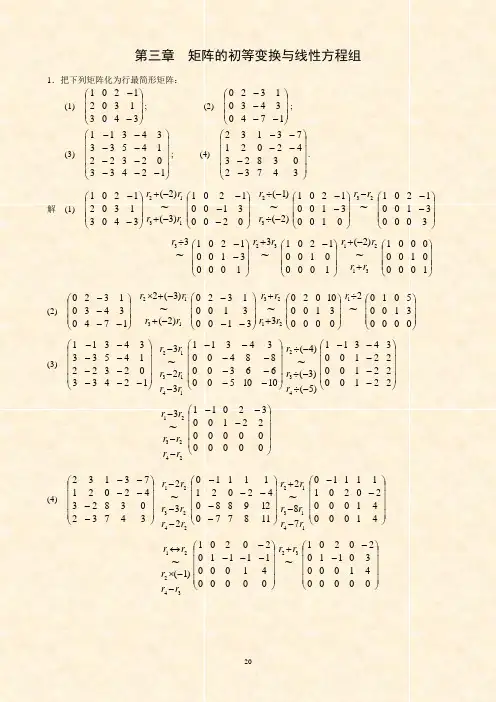
第三章 矩阵的初等变换与线性方程组1.把下列矩阵化为行最简形矩阵:(1) ⎪⎪⎪⎭⎫ ⎝⎛--340313021201; (2) ⎪⎪⎪⎭⎫⎝⎛----174034301320; (3) ⎪⎪⎪⎪⎭⎫⎝⎛---------12433023221453334311; (4) ⎪⎪⎪⎪⎭⎫⎝⎛------34732038234202173132.解 (1) ⎪⎪⎪⎭⎫ ⎝⎛--340313*********2)3()2(~r r r r -+-+⎪⎪⎪⎭⎫ ⎝⎛---020********* )2()1(32~-÷-÷r r ⎪⎪⎪⎭⎫ ⎝⎛--01003100120123~r r -⎪⎪⎪⎭⎫⎝⎛--300031001201 33~÷r ⎪⎪⎪⎭⎫ ⎝⎛--100031001201323~r r +⎪⎪⎪⎭⎫ ⎝⎛-1000010012013121)2(~r r r r +-+⎪⎪⎪⎭⎫ ⎝⎛100001000001(2) ⎪⎪⎪⎭⎫ ⎝⎛----1740343013201312)2()3(2~r r r r -+-+⨯⎪⎪⎪⎭⎫ ⎝⎛---31003100132021233~r r r r ++⎪⎪⎪⎭⎫ ⎝⎛000031001002021~÷r ⎪⎪⎪⎭⎫⎝⎛000031005010 (3) ⎪⎪⎪⎪⎭⎫⎝⎛---------12433023221453334311141312323~rr r r rr ---⎪⎪⎪⎪⎭⎫ ⎝⎛--------1010500663008840034311)5()3()4(432~-÷-÷-÷r r r ⎪⎪⎪⎪⎭⎫ ⎝⎛-----22100221002210034311 2423213~r r r r r r ---⎪⎪⎪⎪⎭⎫⎝⎛---000000000022********(4) ⎪⎪⎪⎪⎭⎫⎝⎛------34732038234202173132 242321232~r r r r rr ---⎪⎪⎪⎪⎭⎫ ⎝⎛-----1187701298804202111110141312782~rr r r rr --+⎪⎪⎪⎪⎭⎫⎝⎛--410004100020201111134221)1(~r r r r r --⨯↔⎪⎪⎪⎪⎭⎫⎝⎛----0000041000111102020132~rr +⎪⎪⎪⎪⎭⎫⎝⎛--000004100030110202012.设⎪⎪⎪⎭⎫ ⎝⎛=⎪⎪⎪⎭⎫ ⎝⎛⎪⎪⎪⎭⎫ ⎝⎛987654321100010101100001010A ,求A 。
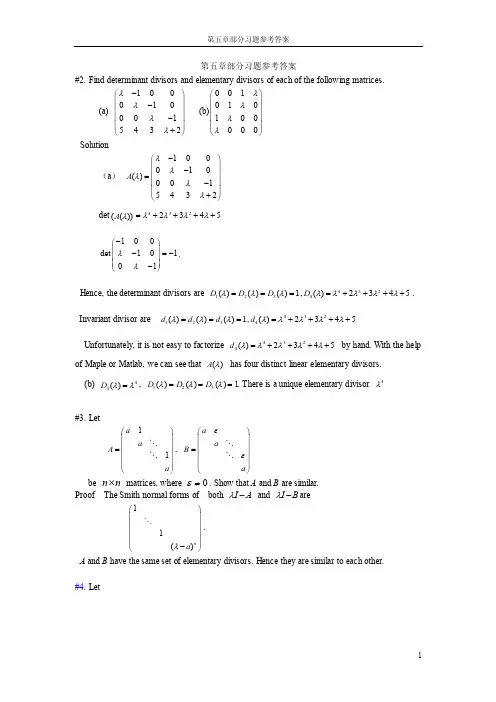
第五章部分习题参考答案#2. Find determinant divisors and elementary divisors of each of the following matrices.(a) 1000100015432λλλλ-⎛⎫ ⎪-⎪ ⎪- ⎪+⎝⎭ (b)001010100000λλλλ⎛⎫⎪ ⎪ ⎪ ⎪⎝⎭Solution(a ) 100010()0015432A λλλλλ-⎛⎫ ⎪- ⎪= ⎪- ⎪+⎝⎭det (())A λ4322345λλλλ=++++100det 10101λλ-⎛⎫⎪-=- ⎪ ⎪-⎝⎭. Hence, the determinant divisors are 123()()()1D D D λλλ===,4324()2345D λλλλλ=++++. Invariant divisor are 123()()()1d d d λλλ===,4324()2345d λλλλλ=++++Unfortunately, it is not easy to factorize 4324()2345d λλλλλ=++++ by hand. With the help of Maple or Matlab, we can see that ()A λ has four distinct linear elementary divisors. (b) 44()D λλ=, 123()()()1D D D λλλ===. There is a unique elementary divisor 4λ #3. Let11a a A a ⎛⎫ ⎪ ⎪= ⎪ ⎪⎝⎭ , a a B a εε⎛⎫ ⎪⎪= ⎪ ⎪⎝⎭ be n n ⨯ matrices, where 0ε≠. Show that A and B are similar.Proof The Smith normal forms of both I A λ- and I B λ-are11()n a λ⎛⎫ ⎪⎪ ⎪ ⎪-⎝⎭. A and B have the same set of elementary divisors. Hence they are similar to each other. #4. Let11a a A a ⎛⎫ ⎪ ⎪= ⎪ ⎪⎝⎭ , 11a a B a ε⎛⎫ ⎪⎪= ⎪ ⎪⎝⎭be n n ⨯ matrices, where 0ε≠. Show that A and B are NOT similar. ProofThe determinant of I A λ- is ()n a λ- . The determinant of I B λ- is ()n a λε--. A and B have distinct characteristic polynomials. Hence, they are not similar.#11. How many possible Jordan forms are there for a 66⨯ complex matrix with characteristic polynomial 42(2)(1)x x +-?Solution The possibilities for the sets of elementary divisors are { 42(2),(1)x x +-}, {4(2),(1),(1)x x x +--}{32(2),(2),(1)x x x ++-}, {3(2),(2),(1),(1)x x x x ++--} {222(2),(2),(1)x x x ++-}, {22(2),(2),(1),(1)x x x x ++--},{22(2),(2),(2),(1)x x x x +++-}, {2(2),(2),(2),(1),(1)x x x x x +++--}{2(2),(2),(2),(2),(1)x x x x x ++++-}, {(2),(2),(2),(2),(1),(1)x x x x x x ++++--}. For each set of elementary divisors, there is a Jordan canonical form up to similarity. There are 10 Jordan canonical forms up to similarity.#12. Classify up to similarity all 33⨯ complex matrices A such that 3A I =. Solution An annihilating polynomial of A is 321(1)()()x x x x ωω-=---, where ω A is diagonalizable.The possibilities for the minimal polynomial of A are1x -, x ω-, 2x ω-;(1x -)(x ω-), (x ω-)(2x ω-), (1x -)(2x ω-);2(1)()()x x x ωω---Up to similarity, all 33⨯ complex matrices A are100010001⎛⎫ ⎪ ⎪ ⎪⎝⎭, 000000ωωω⎛⎫⎪ ⎪ ⎪⎝⎭, 222000000ωωω⎛⎫ ⎪ ⎪ ⎪⎝⎭; 10001000ω⎛⎫⎪ ⎪ ⎪⎝⎭, 1000000ωω⎛⎫ ⎪ ⎪ ⎪⎝⎭; 22000000ωωω⎛⎫ ⎪⎪ ⎪⎝⎭, 2000000ωωω⎛⎫ ⎪ ⎪ ⎪⎝⎭;221000000ωω⎛⎫⎪ ⎪ ⎪⎝⎭,210001000ω⎛⎫⎪ ⎪ ⎪⎝⎭21000000ωω⎛⎫ ⎪ ⎪ ⎪⎝⎭#14. If N is a nilpotent (幂零的) 33⨯ matrix over C , prove that 21128A I N N =+- satisfies2A I N =+, i.e., A is a square root of I N +. Use the binomial series for 1/2(1)t + to obtain asimilar formula for a square root of I N +, where N is any nilpotent n n ⨯ matrix over C .Use the result above to prove that if c is a non-zero complex number and N is a nilpotent complex matrix, then cI N +has a square root. Now use the Jordan form to prove that every non-singular complex n n ⨯ matrix has a square root.Solution If N is an n n ⨯ matrix and k N O =, then k x is an annihilating polynomial for N . The minimal polynomial of N must be of the form p x , where p n ≤ and p k ≤ since the minimal polynomial of a matrix divides its characteristic polynomial. Thus, n N O =.(1) If N is a nilpotent 33⨯ matrix, then 3N O =. By straightforward computation, we can verify that 2A I N =+.(2) If N is an n n ⨯ nilpotent matrix, n N O =.1/22111111(1)(1)((1)1)122222(1)122!(1)!n n t t t t n -----++=+++++- 1/22111111(1)(1)((1)1)122222()22!(1)!n n I N I N N N n -----++=++++-(3) Since1N c is a nilpotent matrix, 1I N c + has a square root 1/21()I N c+. cI N + has a square root 1/21/21()c I N c+.(4) Suppose that 12121()0()000()r d d d r J J P AP J J λλλ-⎛⎫ ⎪⎪==⎪ ⎪ ⎪⎝⎭. Then each ()k d k J λ has asquare root 1/2()k d k J λ since ()k d k J λ is of the form k I N λ+, where 0k λ≠ because A is nonsingular and N is nilpotent.Let 121/211/2211/2()000()000()r d d d r J J B P P J λλλ-⎛⎫⎪⎪=⎪ ⎪⎪⎝⎭, then 2B A =. Hence, A has a squareroot.#20. Prove that the minimal polynomial of a matrix is equal to the characteristic polynomial if andonly if the elementary divisors are relatively prime in pairs.Proof Suppose that a Jordan canonical form of A is1212()000()000()r d d d r J J J J λλλ⎛⎫⎪ ⎪=⎪ ⎪ ⎪⎝⎭(where 12,,,r λλλ are not necessarily distinct. Each ()i d i J λ is a Jordan block.)The minimal polynomial of A is the same as that of J . The characteristic polynomial of A is the same as that of J . The elementary divisors of A are 11()d λλ-, , ()rd r λλ-The minimal polynomial of ()i d i J λ is ()i d i λλ-. The minimal polynomial of J is the least common multiple (最小公倍式) of 11()d λλ-, , ()rd r λλ-. The characteristicpolynomial of J is 1212()()()()rd d d r p λλλλλλλ=--- .The least common divisor of 11()d λλ-, , ()rd r λλ- is equal to the product of11()d λλ-, , ()r d r λλ- if and only if ()j dj λλ-and ()k d k λλ-are relatively prime forj k ≠. Thus the minimal polynomial of a matrix is equal to the characteristic polynomial ifand only if the elementary divisors are relatively prime in pairs.。

南航矩阵论课后习题答案南航矩阵论课后习题答案矩阵论是数学中的一个重要分支,广泛应用于各个领域,包括物理学、工程学、计算机科学等等。
南航的矩阵论课程是培养学生数学思维和解决实际问题的重要环节。
在课后习题中,学生需要运用所学的矩阵理论知识,解答各种问题。
下面是南航矩阵论课后习题的一些答案和解析。
1. 已知矩阵A = [1 2 3; 4 5 6; 7 8 9],求A的逆矩阵。
解析:要求一个矩阵的逆矩阵,需要先判断该矩阵是否可逆。
一个矩阵可逆的充要条件是其行列式不为零。
计算矩阵A的行列式,得到det(A) = -3。
因此,矩阵A可逆。
接下来,我们可以使用伴随矩阵法求解逆矩阵。
首先,计算矩阵A的伴随矩阵Adj(A),然后将其除以行列式的值,即可得到逆矩阵。
计算得到A的伴随矩阵为Adj(A) = [-3 6 -3; 6 -12 6; -3 6 -3]。
最后,将伴随矩阵除以行列式的值,即可得到矩阵A的逆矩阵A^-1 = [-1 2 -1; 2 -4 2; -1 2 -1]。
2. 已知矩阵A = [2 1; 3 4],求A的特征值和特征向量。
解析:要求一个矩阵的特征值和特征向量,需要先求解其特征方程。
特征方程的形式为|A - λI| = 0,其中A为给定矩阵,λ为特征值,I为单位矩阵。
计算得到特征方程为|(2-λ) 1; 3 (4-λ)| = (2-λ)(4-λ) - 3 = λ^2 - 6λ + 5 = 0。
解这个二次方程,得到特征值λ1 = 1,λ2 = 5。
接下来,我们可以求解对应于每个特征值的特征向量。
将特征值代入(A - λI)x = 0,即可求解出特征向量。
对于特征值λ1 = 1,解得特征向量x1 = [1; -1];对于特征值λ2 = 5,解得特征向量x2 = [1; 3]。
3. 已知矩阵A = [1 2; 3 4],求A的奇异值分解。
解析:奇异值分解是将一个矩阵分解为三个矩阵的乘积:A = UΣV^T,其中U和V是正交矩阵,Σ是对角矩阵。
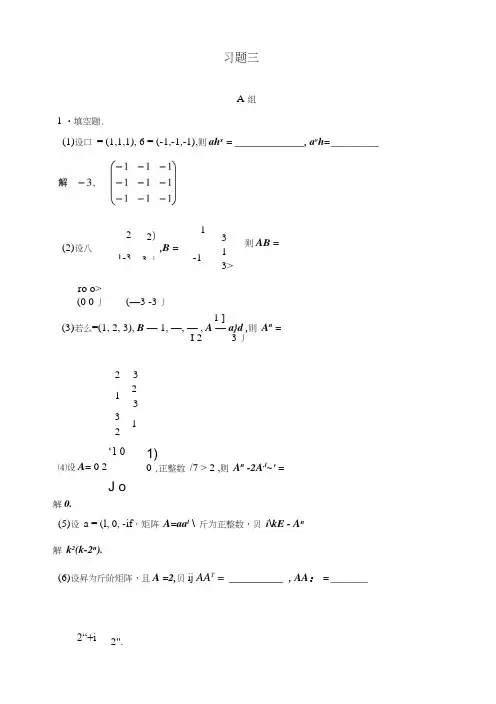
习题三A 组1 •填空题.(1)设口 = (1,1,1), 6 = (-1,-1,-1),则ah x= _____________ , a vh= _________ro o>1 ](3)若么=(1, 2, 3), B — 1, —, — , A — a}d ,则 A n =I 2 3丿‘1 0⑷设A= 0 2J o解0.(5)设 a = (l, 0, -if ,矩阵 A=aa l \ 斤为正整数,贝 i\kE - A n解 k 2(k-2n ).(6)设昇为斤阶矩阵,且A =2,贝ij AA T= _________ , AA : = _______2(2)设八1-3 2),B =-3丿1 -13 1 3>则AB = (0 0丿(—3 -3丿2 13232 3 1 1)0 ,正整数 /7 > 2 ,则 A n -2A ,l ~' =2“+i2".(cos& -sin&\(7)、sin& cos& 丿cos& sin&\、一sin& cos& 丿0 0、2 0 ,则(A*y =4 5,解討丫2(10)设矩阵/二,矩阵B满足BA = B + 2E,则B二,B<-1 2(2 0(11)设/,〃均为三阶矩阵,AB = 2A + B f B= 0 4,2 0‘0 0 P解0 1 0b o oj(12)设三阶矩阵/满足|力|二*, (3A)~l-2A* =1627(13)设/为加阶方阵,B为兀阶方阵,同=Q,\B\ = b, C =°, 则\c\ =(8)设…®?工0 ,则、\Z曾丿1)a n1%■■1 1■色丿丿a lP(9)设A= 22、0 ,贝=2丿/0、0 ,矩阵〃满足关系式ABA =2BA ^E,其屮才'为力的伴随矩阵,则|B | =解*•解0.解一3・是nxp 矩阵,C 是pxm 矩阵,加、n 、p 互不相等,则下列运算没有(B) ABC ;解D.(2)设/是mxn 矩阵(m n), B 是nxm 矩阵,则下列解(一l)〃5b ・(15)设4阶矩阵/的秩为1,则其伴随矩阵/的秩为 (14)设三阶矩阵/ =R(4)解1.(17)设矩阵力'a 、b\ a }b 2■ ■a 2b 2 ■ • ■a n b2,其中匕・工0, (Z=l,2,•••,/?),则力的秩,且7?(J) = 3,则丘=0、 -2i,则将/可以表示成以下三个初等矩阵的乘积(D) AC T .的运算结果是n 阶力•阵.(A) AB ;解B.(B) A YBT;(C) B r A T ;(D) (4B)T.(16 )设?1 = •咕、 ・仇 ・ a n b n)解2.选择题.(1)设/是mxn 矩阵,(3) 设力」是斤阶方阵,AB = O,贝I 」有 ________ • (A) A = B = Ox(B) A + B = O ; (C)同=0或|同=0;(D)同 + 圖=0・解C ・(4) 设力,〃都是斤阶矩阵,则必有 _______ . (A) \A + B\ = \^ + \B\; (B) AB = BA ; (C) \AB\ = \BA\ ;(D) (/1 + B)T M /T + BT ・解C ・(5) 设/,B 是斤阶方阵,下列结论正确的是 __________ ・ (A)若均可逆,则A^B 可逆; (B)若力,〃均可逆,则力〃可逆; (C)若A + B 可逆,则A-B 可逆;(D)若A + B 可逆,则4〃均可逆.解B.(6) 设斤阶方阵A,B,C 满足关系式 ABC = E ,则必有 ___________ ・ (A) ACB = E ; (B) CBA = E ;(C) BAC = E ;(D) BCA = E .解D.(7) 设昇,B,力 + B, /T+BT 均为斤阶可逆矩阵,贝等于 ________________________ (A)(B) A + B ;(C) (D) g + 3)".解C.(8) 设£B,C 均为兀阶矩阵,若B = E + MB , C = A^CA.则B-C 为 ________________ . (A) E\ (B) —E ; (C) ; (D) —A.. 解A.(9) 设矩阵A = (a i .} 满足才其中才是/的伴随矩阵,川为昇的转置矩阵.若\ "3x3。
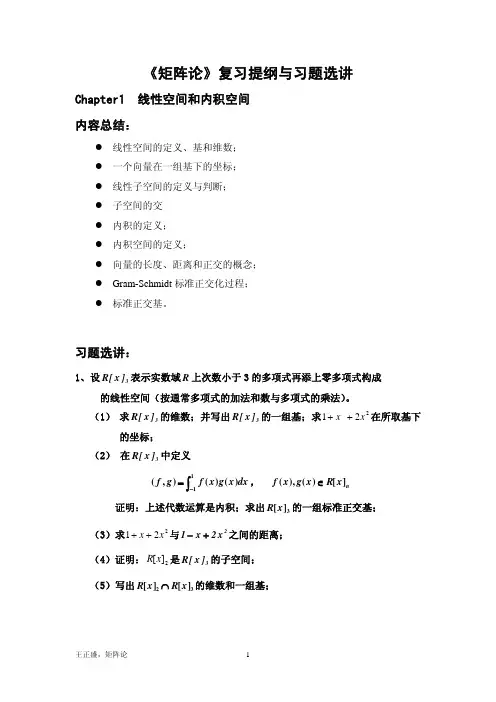
《矩阵论》复习提纲与习题选讲Chapter1 线性空间和内积空间内容总结:z 线性空间的定义、基和维数;z 一个向量在一组基下的坐标;z 线性子空间的定义与判断;z 子空间的交z 内积的定义;z 内积空间的定义;z 向量的长度、距离和正交的概念;z Gram-Schmidt 标准正交化过程;z 标准正交基。
习题选讲:1、设表示实数域3]x [R R 上次数小于3的多项式再添上零多项式构成 的线性空间(按通常多项式的加法和数与多项式的乘法)。
(1) 求的维数;并写出的一组基;求在所取基下的坐标;3]x [R 3]x [R 221x x ++ (2) 在中定义3]x [R , ∫−=11)()(),(dx x g x f g f n x R x g x f ][)(),(∈ 证明:上述代数运算是内积;求出的一组标准正交基;3][x R (3)求与之间的距离;221x x ++2x 2x 1+−(4)证明:是的子空间;2][x R 3]x [R (5)写出2[][]3R x R x ∩的维数和一组基;二、 设22R ×是实数域R 上全体22×实矩阵构成的线性空间(按通常矩阵的加 法和数与矩阵的乘法)。
(1) 求22R ×的维数,并写出其一组基;(2) 在(1)所取基下的坐标; ⎥⎦⎤⎢⎣⎡−−3111(3) 设W 是实数域R 上全体22×实对称矩阵构成的线性空间(按通常矩阵的加法和数与矩阵的乘法)。
证明:W 是22R ×的子空间;并写出W 的维数和一组基;(4) 在W 中定义内积, )A B (tr )B ,A (T =W B ,A ∈求出W 的一组标准正交基;(5)求与之间的距离; ⎥⎦⎤⎢⎣⎡0331⎥⎦⎤⎢⎣⎡−1221 (6)设V 是实数域R 上全体22×实上三角矩阵构成的线性空间(按通常矩阵的加法和数与矩阵的乘法)。
证明:V 也是22R ×的子空间;并写出V 的维数和一组基;(7)写出子空间的一组基和维数。
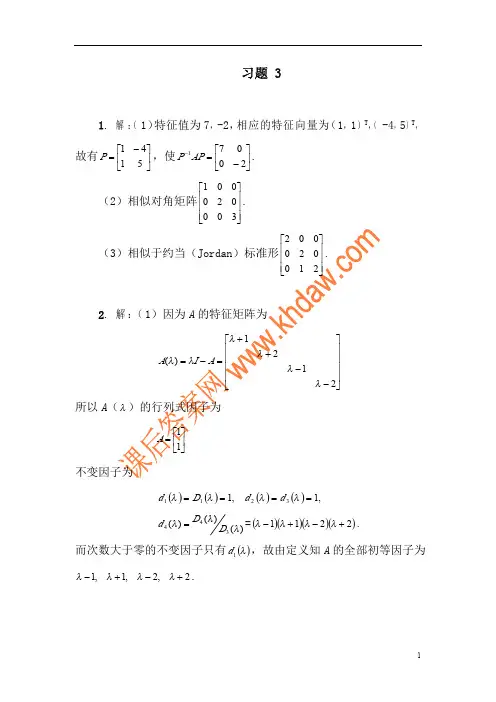

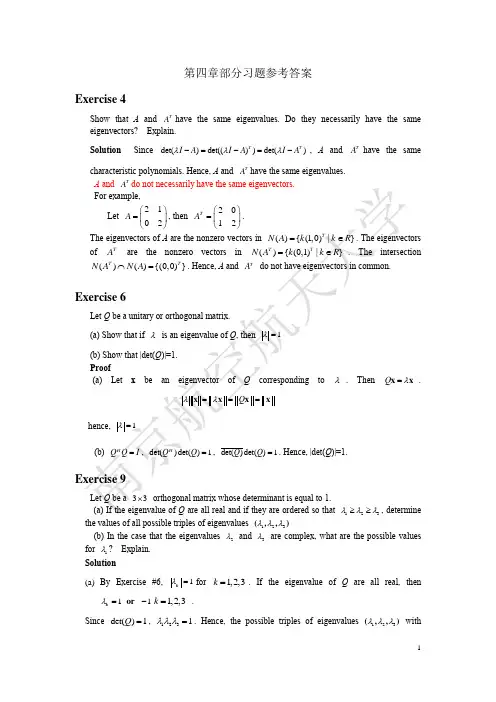
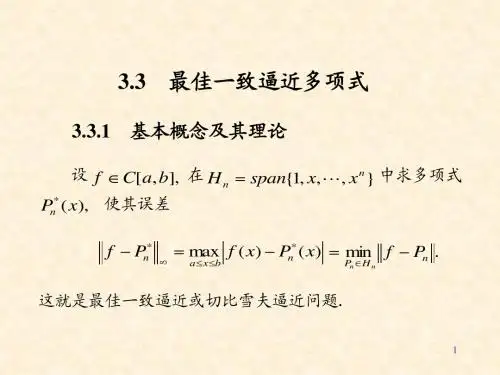
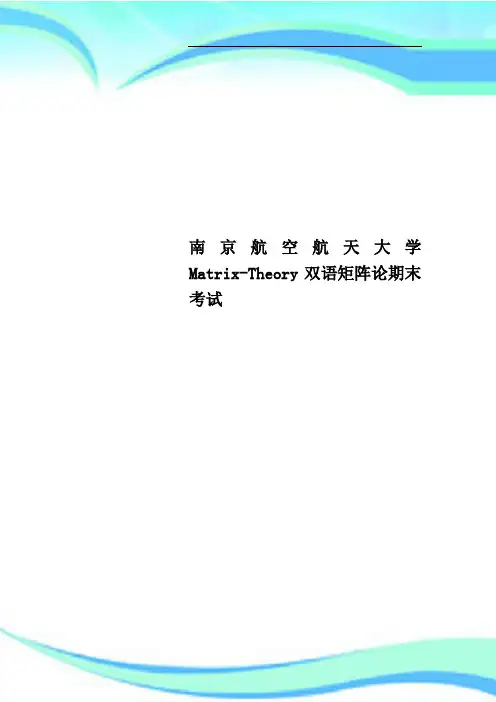
第五章部分习题参考答案Exercise 2Find determinant divisors and elementary divisors of each of the following matrices.(a) 1000100016733λλλλ-⎛⎫ ⎪- ⎪ ⎪- ⎪--+⎝⎭ (b)001010100000λλλλ⎛⎫⎪ ⎪ ⎪ ⎪⎝⎭ Solution(a ) 100010()0016733A λλλλλ-⎛⎫ ⎪-⎪= ⎪- ⎪--+⎝⎭det (())A λ432323376(1)(46)λλλλλλλλ=+--+=-++-222(1)(56)(1)(2)(3)λλλλλλ=-++=-++There is a 3x3 submatrix whose determinant is100det 10101λλ-⎛⎫ ⎪-=- ⎪ ⎪-⎝⎭. Hence, the determinant divisors are 123()()()1D D D λλλ===,4324()3376D λλλλλ=+--+. Invariant divisor are 123()()()1d d d λλλ===,4324()3376d λλλλλ=+--+ The elementary divisors of ()A λ are 2(1)λ-, 2λ+, 3λ+(b) 44()D λλ=, 123()()()1D D D λλλ===. There is a unique elementary divisor 4λExercise 3Let11a a A a ⎛⎫ ⎪ ⎪= ⎪ ⎪⎝⎭ , a a B a εε⎛⎫ ⎪⎪= ⎪ ⎪⎝⎭be n n ⨯ matrices, where 0ε≠. Show that A and B are similar.Proof The Smith normal forms of both I A λ- and I B λ-are11()n a λ⎛⎫ ⎪⎪ ⎪ ⎪-⎝⎭.A andB have the same set of elementary divisors. Hence they are similar to each other.Exercise 4Let11a a A a ⎛⎫ ⎪ ⎪= ⎪ ⎪⎝⎭ , 11a a B a ε⎛⎫ ⎪⎪= ⎪ ⎪⎝⎭be n n ⨯ matrices, where 0ε≠. Show that A and B are NOT similar.ProofThe determinant of I A λ- is ()n a λ- . The determinant of I B λ- is ()n a λε--. A and B have distinct characteristic polynomials. Hence, they are not similar.Exercise 6For each of the following matrices, find the Jordan Canonical Form J and matrix P such that 1P AP J -=(a) 040140122-⎛⎫ ⎪- ⎪ ⎪--⎝⎭(b)134478677-⎛⎫⎪- ⎪ ⎪-⎝⎭Solution(a)40140122I A λλλλ⎛⎫ ⎪-=-+ ⎪ ⎪-+⎝⎭Determinant divisors are 33()det()(2)D I A λλλ=-=+, 2()det()(2)D I A λλλ=-=+,1()1D λ= Invariant divisors are 23()(2)d λλ=+, 2()(2)d λλ=+, 1()1d λ= Elementary divisors are 2(2)λ+, (2)λ+A Jordan canonical form is 210020002-⎛⎫⎪- ⎪ ⎪-⎝⎭. Let123(,,)p p p P =, then1121233222p p p p p p p A A A =-=-=-Solving (2)x 0A I +=, that is, 123240012001200x x x -⎛⎫⎛⎫⎛⎫ ⎪⎪ ⎪-= ⎪⎪ ⎪ ⎪⎪ ⎪-⎝⎭⎝⎭⎝⎭, we obtain that {1p ,3p } form abasis for (2)((0,0,1),(2,1,0))T T N I A Span -= . Let 1(2,1,0)(0,0,1),p T T a b =+ To obtain 2p , we solve the system212(2)p p a A I a b ⎛⎫⎪-== ⎪ ⎪⎝⎭, that is,1232402120120y a y a y b -⎛⎫⎛⎫⎛⎫ ⎪⎪ ⎪-= ⎪⎪ ⎪ ⎪⎪ ⎪-⎝⎭⎝⎭⎝⎭. This system is consistent only if a b =. Let 1a b ==. Then 1(2,1,1)p T =, We solve the system above for vector2(1,0,0)p T =. Take 3(0,0,1)p T =.210100101P ⎛⎫ ⎪= ⎪ ⎪⎝⎭(b) 134478677I A λλλλ--⎛⎫ ⎪-=-+- ⎪ ⎪--⎝⎭23()det()(1)(3)D I A λλλλ=-=+-, 2()1D λ= , 1()1D λ=Invariant divisors are 23()(1)(3)d λλλ=+-, 2()1d λ=, 1()1d λ= Elementary divisors are 2(1)λ+, (3)λ-A Jordan canonical form is 110010003-⎛⎫⎪- ⎪ ⎪⎝⎭. Let123(,,)p p p P =, then11212333p p p p p p p A A A =-=-= 3(1,2,2)p T =, 1(1,2,1)p T =, 2(1,1,0)p T =--111212102P -⎛⎫⎪=- ⎪ ⎪⎝⎭Exercise 8Show that if p A I = for some positive integer p , then A is similar to a diagonal matrix over the complex number field.Proof Since p A I =, 1p x - is an annihilating polynomial. The minimal polynomial ()m x of A must divide 1p x -. Since the polynomial 1p x - has only single roots(单根),()m x has only single roots. Therefore, by Theorem 5.2.7 (see lecture notes p124), matrix A is diagonalizable.Exercise 9Prove that if an n n ⨯ matrix satisfies 256A A I -=then A is diagonalizable.Proof Since 256A A I -=, 256x x -- is an annihilating polynomial of A . . The minimal polynomial ()m x of A must divide 256x x --. Since 256(6)(1)x x x x --=-+, the minimal polynomial must be a product of distinct linear factors. By Theorem 5.2.7 (see lecture notes p124), matrix A is diagonalizable.Exercise 10Show that if A is nonsingular, then 1A - can be written as a polynomial of A .Proof Let 1110()n n n p x c c c λλλ--=++++ be the characteristic polynomial of A . The constant term of ()p x must not be zero since A is nonsingular. By Cayley-Hamilton Theorem,()p A O =. That is, 1110n n n A c A c A c I O --++++= . Thus,1121101()n n n A A c A c I c ----=-+++ , which is a polynomial of A .Exercise 11How many possible Jordan forms are there for a 66⨯ complex matrix with characteristic polynomial 42(2)(1)x x +-?Solution The possibilities for the sets of elementary divisors are { 42(2),(1)x x +-}, {4(2),(1),(1)x x x +--}{32(2),(2),(1)x x x ++-}, {3(2),(2),(1),(1)x x x x ++--} {222(2),(2),(1)x x x ++-}, {22(2),(2),(1),(1)x x x x ++--},{22(2),(2),(2),(1)x x x x +++-}, {2(2),(2),(2),(1),(1)x x x x x +++--}{2(2),(2),(2),(2),(1)x x x x x ++++-}, {(2),(2),(2),(2),(1),(1)x x x x x x ++++--}. For each set of elementary divisors, there is a Jordan canonical form up to similarity. There are 10 Jordan canonical forms up to similarity.Exercise 12Classify up to similarity all 33⨯ complex matrices A such that 3A I =.Solution An annihilating polynomial of A is 321(1)()()x x x x ωω-=---, where ω= A is diagonalizable.The possibilities for the minimal polynomial of A are1x -, x ω-, 2x ω-;(1x -)(x ω-), (x ω-)(2x ω-), (1x -)(2x ω-);2(1)()()x x x ωω---Up to similarity, all 33⨯ complex matrices A are100010001⎛⎫ ⎪ ⎪ ⎪⎝⎭, 000000ωωω⎛⎫⎪ ⎪ ⎪⎝⎭, 222000000ωωω⎛⎫ ⎪ ⎪ ⎪⎝⎭; 10001000ω⎛⎫⎪ ⎪ ⎪⎝⎭, 1000000ωω⎛⎫ ⎪ ⎪ ⎪⎝⎭; 22000000ωωω⎛⎫ ⎪⎪ ⎪⎝⎭, 2000000ωωω⎛⎫ ⎪ ⎪ ⎪⎝⎭;221000000ωω⎛⎫⎪ ⎪ ⎪⎝⎭,210001000ω⎛⎫⎪ ⎪ ⎪⎝⎭21000000ωω⎛⎫ ⎪ ⎪ ⎪⎝⎭Exercise 14If N is a nilpotent (幂零的) 33⨯ matrix over C , prove that 21128A I N N =+- satisfies2A I N =+, i.e., A is a square root of I N +. Use the binomial series for 1/2(1)t + to obtain asimilar formula for a square root of I N +, where N is any nilpotent n n ⨯ matrix over C .Use the result above to prove that if c is a non-zero complex number and N is a nilpotent complex matrix, then cI N +has a square root. Now use the Jordan form to prove that every non-singular complex n n ⨯ matrix has a square root.Solution If N is an n n ⨯ matrix and k N O =, then k x is an annihilating polynomial for N . The minimal polynomial of N must be of the form p x , where p n ≤ and p k ≤ since the minimal polynomial of a matrix divides its characteristic polynomial. Thus, n N O =.(1) If N is a nilpotent 33⨯ matrix, then 3N O =. By straightforward computation, we canverify that 2A I N =+.(2) If N is an n n ⨯ nilpotent matrix, n N O =.1/22111111(1)(1)((1)1)122222(1)122!(1)!n n t t t t n -----++=+++++- 1/22111111(1)(1)((1)1)122222()22!(1)!n n I N I N N N n -----++=++++-(3) Since1N c is a nilpotent matrix, 1I N c + has a square root 1/21()I N c+. cI N + has a square root 1/21/21()c I N c+.(4) Suppose that 12121()00()000()r d d d r J J P AP J J λλλ-⎛⎫ ⎪⎪==⎪ ⎪ ⎪⎝⎭. Then each ()k d k J λ has asquare root 1/2()k d k J λ since ()kd k J λ is of the form k I N λ+, where 0k λ≠ because A is nonsingular and N is nilpotent.Let 121/211/2211/2()000()000()r d d d r J J B P P J λλλ-⎛⎫⎪⎪=⎪ ⎪⎪⎝⎭, then 2B A =. Hence, A has a squareroot.Exercise 20Prove that the minimal polynomial of a matrix is equal to the characteristic polynomial if andonly if the elementary divisors are relatively prime in pairs.Proof Suppose that a Jordan canonical form of A is1212()000()000()r d d d r J J J J λλλ⎛⎫ ⎪⎪= ⎪ ⎪⎪⎝⎭(where 12,,,r λλλ are not necessarily distinct. Each ()id i J λ is a Jordan block.)The minimal polynomial of A is the same as that of J . The characteristic polynomial of A is the same as that of J . The elementary divisors of A are 11()d λλ-, , ()rd r λλ-The minimal polynomial of ()id i J λ is ()id i λλ-. The minimal polynomial of J is theleast common multiple (最小公倍式) of 11()d λλ-, , ()rd r λλ-. The characteristicpolynomial of J is 1212()()()()rd d d r p λλλλλλλ=--- .The least common divisor of 11()d λλ-, , ()rd r λλ- is equal to the product of11()d λλ-, , ()r d r λλ- if and only if ()j dj λλ-and ()k d k λλ-are relatively prime for j k ≠. Thus the minimal polynomial of a matrix is equal to the characteristic polynomial ifand only if the elementary divisors are relatively prime in pairs.。
第三章1、 已知()ij A a =是n 阶正定Hermite 矩阵,在n 维线性空间n C 中向量1212(,,,),(,,,)n n x x x y y y αβ== 定义内积为(,)H A αβαβ=(1) 证明在上述定义下,n C 是酉空间; (2) 写出n C 中的Canchy-Schwarz 不等式。
2、 已知2111311101A --⎡⎤=⎢⎥-⎣⎦,求()N A 的标准正交基。
提示:即求方程0AX =的基础解系再正交化单位化。
3、 已知308126(1)316,(2)103205114A A --⎡⎤⎡⎤⎢⎥⎢⎥=-=-⎢⎥⎢⎥⎢⎥⎢⎥----⎣⎦⎣⎦试求酉矩阵U ,使得HU AU 是上三角矩阵。
提示:参见教材上的例子4、 试证:在nC 上的任何一个正交投影矩阵P 是半正定的Hermite 矩阵。
5、 验证下列矩阵是正规矩阵,并求酉矩阵U ,使HU AU 为对角矩阵,已知131(1)612A ⎡⎢⎢⎢=⎢⎢⎢⎥⎢⎥⎣⎦01(2)10000i A i -⎡⎤⎢⎥=⎢⎥⎢⎥⎣⎦,434621(3)44326962260ii i A i i i i i +--⎡⎤⎢⎥=----⎢⎥⎢⎥+--⎣⎦11(4)11A -⎡⎤=⎢⎥⎣⎦6、 试求正交矩阵Q ,使TQ AQ 为对角矩阵,已知220(1)212020A -⎡⎤⎢⎥=--⎢⎥⎢⎥-⎣⎦,11011110(2)01111011A -⎡⎤⎢⎥-⎢⎥=⎢⎥-⎢⎥-⎣⎦7、 试求矩阵P ,使H P AP E =(或T P AP E =),已知11(1)01112i i A i i +⎡⎤⎢⎥=-⎢⎥⎢⎥-⎣⎦,222(2)254245A -⎡⎤⎢⎥=-⎢⎥⎢⎥--⎣⎦8、 设n 阶酉矩阵U 的特征根不等于1-,试证:矩阵E U +满秩,且1()()H i E U E U -=-+是Hermite 矩阵。
反之,若H 是Hermite 矩阵,则E iH +满秩,且1()()U E iH E iH -=+-是酉矩阵。
NUAALet 3P (the vector space of real polynomials of degree less than 3) defined by(())'()''()p x xp x p x σ=+.(1) Find the matrix A representing σ with respect to the ordered basis [21,,x x ] for 3P .(2) Find a basis for 3P such that with respect to this basis, the matrix B representing σ is diagonal.(3) Find the kernel (核) and range (值域)of this transformation. Solution: (1)221022x x x x σσσ===+()()() 002010002A ⎛⎫⎪= ⎪ ⎪⎝⎭----------------------------------------------------------------------------------------------------------------- (2)101010001T ⎛⎫ ⎪= ⎪ ⎪⎝⎭(The column vectors of T are the eigenvectors of A)The corresponding eigenvectors in 3P are 1000010002T AT -⎛⎫⎪= ⎪ ⎪⎝⎭(T diagonalizes A ) 22[1,,1][1,,]x x x x T += . With respect to this new basis 2[1,,1]x x +, the representingmatrix of σis diagonal.------------------------------------------------------------------------------------------------------------------- (3) The kernel is the subspace consisting of all constant polynomials.The range is the subspace spanned by the vectors 2,1x x +-----------------------------------------------------------------------------------------------------------------------Let 020012A ⎛⎫⎪= ⎪ ⎪-⎝⎭.(1) Find all determinant divisors and elementary divisors of A .(2) Find a Jordan canonical form of A .(3) Compute At e . (Give the details of your computations.) Solution: (1)110020012I A λλλλ-⎛⎫ ⎪-=- ⎪ ⎪-⎝⎭,(特征多项式 2()(1)(2)p λλλ=--. Eigenvalues are 1, 2, 2.)Determinant divisor of order 1()1D λ=, 2()1D λ=, 23()()(1)(2)D p λλλλ==-- Elementary divisors are 2(1) and (2)λλ-- .---------------------------------------------------------------------------------------------------------------------- (2) The Jordan canonical form is100021002J ⎛⎫ ⎪= ⎪ ⎪⎝⎭--------------------------------------------------------------------------------------------------------------------------(3) For eigenvalue 1, 010010011I A ⎛⎫⎪-=- ⎪ ⎪-⎝⎭ , An eigenvector is 1(1,0,0)T p = For eigenvalue 2, 1102000010I A ⎛⎫⎪-= ⎪ ⎪⎝⎭, An eigenvector is 2(0,0,1)T p =Solve 32(2)A I p p -=, 331100(2)00000101A I p p --⎛⎫⎛⎫⎪ ⎪-== ⎪ ⎪ ⎪ ⎪-⎝⎭⎝⎭we obtain that3(1,1,0)T p =-101001010P ⎛⎫ ⎪=- ⎪ ⎪⎝⎭, 1110001010P -⎛⎫⎪= ⎪ ⎪-⎝⎭ 1At J e Pe P -=22210100110001000101000010tt t t e e te e ⎛⎫⎛⎫⎛⎫⎪ ⎪ ⎪=- ⎪ ⎪ ⎪ ⎪ ⎪ ⎪-⎝⎭⎝⎭⎝⎭22220000t t t t t t e e e e tee ⎛⎫-⎪= ⎪ ⎪-⎝⎭ --------------------------------------------------------------------------------------------------------------------Suppose that ∈R A and O I A A =--65.(1) What are the possible minimal polynomials of A ? Explain.(2) In each case of part (1), what are the possible characteristic polynomials of A ? Explain.Solution:(1) An annihilating polynomial of A is 256x x --.The minimal polynomial of A divides any annihilating polynomial of A. The possible minimal polynomials are6x -, 1x +, and 256x x --.---------------------------------------------------------------------------------------------------------------(2) The minimal polynomial of A divides the characteristic polynomial of A. Since A is a matrix of order 3, the characteristic polynomial of A is of degree 3. The minimal polynomial of A and the characteristic polynomial of A have the same linear factors. Case 6x -, the characteristic polynomial is 3(6)x - Case 1x +, the characteristic polynomial is 3(1)x + Case 256x x --, the characteristic polynomial is 2(1)(6)x x +- or 2(6)(1)x x -+-------------------------------------------------------------------------------------------------------------------Let 120000A ⎛⎫=⎪⎝⎭. Find the Moore-Penrose inverse A +of A .Solution: ()12011200000A PG ⎛⎫⎛⎫=== ⎪ ⎪⎝⎭⎝⎭1()(1,0)T T P P P P +-==, 111()250T T G G GG +-⎛⎫⎪== ⎪ ⎪⎝⎭110112(1,0)2055000A G P +++⎛⎫⎛⎫ ⎪⎪=== ⎪ ⎪ ⎪ ⎪⎝⎭⎝⎭也可以用SVD 求.------------------------------------------------------------------------------------------------------------------Part II (选做题, 每题10分)请在以下题目中(第6至第9题)选择三题解答. 如果你做了四题,请在题号上画圈标明需要批改的三题. 否则,阅卷者会随意挑选三题批改,这可能影响你的成绩.Let 4P be the vector space consisting of all real polynomials of degree lessthan 4 with usual addition and scalar multiplication. Let 123,,x x x be three distinct real numbers. For each pair of polynomials f and g in 4P , define 31,()()i i i f g f x g x =<>=∑.Determine whether ,f g <> defines an inner product on 4P or not. Explain.Let n n A ⨯∈R . Show that if x x A =)(σis the orthogonal projection fromn R to )(A R , then A is symmetric and the eigenvalues ofA are all 1’s and 0’s.n n A ⨯∈C . Show that x x A H is real-valued for all n C x ∈if and only if Ais Hermitian.Let n n B A ⨯∈C , be Hermitian matrices, and A bepositive definite. Show thatAB is similar to BA , and is similar to a real diagonal matrix.若正面不够书写,请写在反面.123()()()x x x x x x ---. Then ,0f f <>=. But 0f ≠. This does not define an inner product. For any x , ()()x x T A R A N A ⊥-∈=, ()x x 0T A A -=. Hence, T T A A A =. Thus. T A A =.From above, we have 2A A =. This will imply that λλ-2is an annihilating polynomial of A. The eigenvalue of A must be the roots of 02=-λλ. Thus, the eigenvalues of A are1’s and 0’s.See Thm 7.1.1, page 182. 也可以用其它方法.Since A is nonsingular, 1()AB A BA A -=. Hence, A is similar to BASince A is positive definite, there is a nonsingular hermitian matrix P such that H A PP =. 1()H H AB PP B P P BP P -==Since H P BP is Hermitian, it is similar to a real diagonal matrix.is similar to H AB P BP , H P BP is similar to a real diagonal matrix. Thus AB is similar to a real diagonal matrix.。
第七章部分习题参考答案Exercise 1Show that a normal matrix A is Hermitian if its eigenvalues are all real.Proof If A is a normal matrix, then there is a unitary matrix that diagonalizes A . That is, there is a unitary matrix U such thatHA U D U =where D is a diagonal matrix and the diagonal elements of D are eigenvalues of A . If eigenvalues of A are all real, then()H H H H H H A UDU UD U UDU A ====Therefore, A is Hermitian.Exercise 2Let A and B be Hermitian matrices of the same order. Show that AB is Hermitian if and only ifAB BA =. ProofIf A B B A =, then ()()H H H H AB BA A B AB ===. Hence, AB is Hermitian.Conversely, if AB is Hermitian, then ()H AB AB =. Therefore, H H AB B A BA ==. Exercise 3Let A and B be Hermitian matrices of the same order. Show that A and B are similar if they have the same characteristic polynomial.Proof Since matrix A and B have the same characteristic polynomial, they have the same eigenvalues 12,,,n λλλ . There exist unitary matrices U and V such that12diag(,,,)H n U AU λλλ= , 12diag(,,,)H n V BV μμμ= .Thus,H H U AU V BV =. (11,H H U U V V --==)That is 1()H H UV AUV B -=. Hence, A and B are similar.Exercise 4Let A be a skew-Hermitian matrix, i.e., H A A =-, show that (a) I A - and I A + are invertible.(b) 1()()I A I A --+ is a unitary matrix with eigenvalues not equal to 1-. Proof of Part (a)Method 1: (a) since H A A =-, it follows that()()H I A I A I AA I A A -+=-=+For any x 0≠()()0x x x x x x x x x x H H H H H HH I A A A A A A +=+=+> Hence, ()()I A I A -+ is positive definite. It follows that ()()I A I A -+ is invertible. Hence, both I A - and I A + are invertible.Method 2:If I A - is singular, then there exists a nonzero vector x such that()x 0I A -=. Thus, x x A =,x x x x H H A =. (1)Since x x H is real, it follows that()x x x x H H H A =.That is x x x x H H H A =. Since H A A =-, it follows thatx x x x H H A -= (2)Equation (1) and (2) implies that 0x x H =. This contradicts the assumption that x is nonzero. Therefore, I A - is invertible.Method 3:Let λ be an eigenvalue of A and x be an associated eigenvector. x x A λ=x x x x H H A λ=. ()x x x x x x x x x x x xH H H H H H H H A A A λλ===-=-Hence, λ is either zero or pure imaginary. 1 and 1- can not be eigenvalues of A . Hence, I A -and I A + are invertible.Method 4: Since H A A =-, A is normal. There exists a unitary matrix U such that 12diag(,,,)H n U AU λλλ=12()()diag(,,,)H H H H H H n U AU U A U U AU λλλ==-= 12diag(,,,)n λλλ= 12diag(,,,)n λλλ- Each j λ is pure imaginary or zero.12(diag(,,,))H n I A U I U λλλ-=- 12diag(1,1,,1))H n I A U U λλλ-=---Since 10i λ-≠ for 1,2,,j n = , det ()0I A -≠. Hence, I A - is invertible. Similarly, we can prove that I A + is invertible.Proof of Part (b) Method 1:Since ()()()()I A I A I A I A +-=-+, it follows that11[()()]()()H I A I A I A I A ---+-+11()()()()H H I A I A I A I A --=+--+ ( Note that 11()()H H P P --= if P is nonsingular.) 11()()()()I A I A I A I A --=-+-+ 11()()()()I A I A I A I A I --=--++=Hence, 1()()I A I A --+ is a unitary matrix. Denote 1()()B I A I A -=-+.Since 111(1)(1)()()()()2()I B I I A I A I A I A I A I A -----=---+=-++-+=-+,1det()(2)det[()]0n I B I A ---=-+≠Hence, 1- can not be an eigenvalue of 1()()I A I A --+. Method 2:By method 4 of the Proof of Part (a),12diag(1,1,,1))H n I A U U λλλ-=---12diag(1,1,,1))H n I A U U λλλ+=+++1()()I A I A --+1212111diag(,,,))111H n nU U λλλλλλ---=+++ The eigenvalues of 1()()I A I A --+ are1212111,,,111n nλλλλλλ---+++ , which are all not equal to 1-.Method 3: Since ()()()()I A I A I A I A +-=-+, it follows that 11()()()()I A I A I A I A ---+=+-If 1- is an eigenvalue of 1()()I A I A --+, then there is a nonzero vector x , such that1()()x x I A I A --+=-. That is 1()()x x I A I A -+-=-.It follows that()()x x I A I A -=-+.This implies that x 0=. This contradiction shows that 1- can not be an eigenvalue of1()()I A I A --+.Exercise 6If H is Hermitian, show that i I H - is invertible, and 1(i )(i )U I H I H -=+- is unitary. Proof Let i A H =-. Then A is skew-Hermitian. By Exercises #4, I A - and I A + are invertible, and 1()()U I A I A -=-+ is unitary. This finishes the proof.Exercise 7Find the Hermitian matrix for each of the following quadratic forms. And reduce each quadratic form to its canonical form by a unitary transformation (a) 12312131213(,,)i i f x x x x x x x x x x x =+-+ Solution()1123123230i 1(,,)i 00100x f x x x x x xx x ⎛⎫⎛⎫ ⎪ ⎪=- ⎪⎪ ⎪⎪⎝⎭⎝⎭, 0i 1i 00100A ⎛⎫⎪=- ⎪ ⎪⎝⎭3d e t ()2I A λλλ-=-. Eigenvalues of Aare 1λ2λ=, and 30λ=.Associated unit eigenvectors are1i 1,)22u T =-, 2i 1,)22u T =-, and3u T =, respectively. 123,,u u u form an orthonormal set.Let 123(,,)u u u U =, and x y U =. Then we obtain the canonical form1122y yExercise 9Let A and B be Hermitian matrices of order n , and A be positive definite. Show that AB issimilar to a real diagonal matrix.Proof Since A is positive definite, there exists an nonsingular Hermitian matrix P such thatHA P P = 1()H H AB PP B P P BP P -==AB is similar to H P BP . Since H P BP is Hermitian, it is similar to a real diagonal matrix. Hence, AB is similar to a real diagonal matrix.Exercise 10Let A be an Hermitian matrix of order n . Show that there exists a real number 0t such that t I A +is positive definite. Proof 1: The matrix t I A + is Hermitian for real values of t . If the eigenvalues of A are 12,n λλλ ,,, then the eigenvalues of t I A +are 12,,n t t t λλλ+++ ,. Let12max{,,}n t λλλ> ,Then the eigenvalues of t I A + are all positive. And hence, tI A +is positive definite.Proof 2: The matrix t I A + is Hermitian for real values of t . Let r A be the leading principle minor of A of order r .d e t ()r r r t I A t +=+terms involving lower powers in t .Hence, det()r r t I A + is positive for sufficiently large t .Thus, if t is sufficiently large, all leading principal minors of t I A + will be positive.That is, there exists a real number 0t such that det()r r t I A + is positive for 0t t > and for each r . Thus t I A + is positive definite for 0t t >. Exercise 11 Let11121222HA A A A A ⎛⎫= ⎪⎝⎭be an Hermitian positive definite matrix. Show that 1122det()det()det()A A A ≤Proof We first prove that if A is Hermitian positive definite and B is Hermitian semi-positivedefinite, then det()det()A B A +≥. Since A is positive definite, there exists a nonsingular hermitian matrix P such thatHA P P = 11(())H H AB P I P B P P --+=+ 11det()det()det(())H A B A I P B P --+=+11()H I P B P --+ is positive semi- definite. Its eigenvalues are all greater than or equal to 1.Thus11det(())1H I P B P --+≥111121112112111222H H I O A A I A A A A I A A O I --⎛⎫-⎛⎫⎛⎫⎪ ⎪⎪-⎝⎭⎝⎭⎝⎭11112111112112212111222121112H H A A A O I A A O A A A A O A A A A O I ---⎛⎫-⎛⎫⎛⎫== ⎪ ⎪ ⎪--⎝⎭⎝⎭⎝⎭ 122121112H A A A A -- is positive definite, and 1121112H A A A - is positive semi-definite, and11122121112det()det()det()H A A A A A A -=-Hence, 111222212111212111222121112det()det()det(H H H A A A A A A A A A A A A ---=-+≥-)This finishes the proof.Exercise 12Let A be a positive definite Hermitian matrix of order n . Show that the element in A with the largest norm must be in the main diagonal.Proof Let ()ij A a =. Suppose that 00i j a is of the largest norm, where 00i j ≠. Consider the principal minor 00000000i i i j i j j j a a a a ⎛⎫⎪ ⎪⎝⎭. It must be positive definite since A is positive definite. (Recall that an Hermitian matrix is positive definite iff all its principal minors are positive.) Thus, 00000000det 0i i i j i j j j a a a a ⎛⎫⎪> ⎪⎝⎭. On the other hand, 000000000000002det 0i i i j i i j j i j i j j j a a a a a a a ⎛⎫⎪=-≤ ⎪⎝⎭since 00i j a is of the largest norm.(Remark: The diagonal elements in an Hermitian matrix must be real.)This contradiction implies that the element in A with the largest norm must be in the main diagonal.。
Solution Key to Some Exercises in Chapter 3 #5. Determine the kernel and range of each of the following linear transformations on 2P
(a) (())'()p x xp x σ=
(b) (())()'()p x p x p x σ=-
(c) (())(0)(1)p x p x p σ=+
Solution (a) Let ()p x ax b =+. (())p x ax σ=.
(())0p x σ= if and only if 0ax = if and only if 0a =. Thus, ker(){|}b b R σ=∈
The range of σis 2()P σ={|}ax a R ∈
(b) Let ()p x ax b =+. (())p x ax b a σ=+-.
(())0p x σ= if and only if 0ax b a +-= if and only if 0a =and 0b =.
Thus, ker(){0}σ=
The range of σis 2()P σ=2{|,}P ax b a a b R +-∈=
(c) Let ()p x ax b =+. (())p x bx a b σ=++.
(())0p x σ= if and only if 0bx a b ++= if and only if 0a =and 0b =.
Thus, ker(){0}σ=
The range of σis 2()P σ=2{|,}P bx a b a b R ++∈=
备注: 映射的核以及映射的像都是集合,应该以集合的记号来表达或者用文字来叙述. #7. Let be the linear mapping that maps 2P into 2R defined by
10()(())(0)p x dx p x p σ⎛⎫ ⎪= ⎪⎝⎭
⎰ Find a matrix A such that
()x A ασαββ⎛⎫+= ⎪⎝⎭
. Solution
1(1)1σ⎛⎫= ⎪⎝⎭ 1/2()0x σ⎛⎫
= ⎪⎝⎭ 11/211/2()101
0x ασαβαββ⎛⎫⎛⎫⎛⎫⎛⎫+=+= ⎪ ⎪ ⎪⎪⎝⎭⎝⎭⎝⎭⎝⎭
Hence, 11/210A ⎛⎫= ⎪⎝⎭
#10. Let σ be the transformation on 3P defined by
(())'()"()p x xp x p x σ=+
a) Find the matrix A representing σ with respect to 2[1,,]x x
b) Find the matrix B representing σ with respect to 2[1,,1]x x +
c) Find the matrix S such that 1B S AS -=
d) If 2012()(1)p x a a x a x =+++, calculate (())n p x σ.
Solution (a) (1)0σ=
()x x σ=
22()22x x σ=+
002010002A ⎛⎫ ⎪= ⎪ ⎪⎝⎭
(b) (1)0σ=
()x x σ=
22(1)2(1)x x σ+=+
000010002B ⎛⎫ ⎪= ⎪ ⎪⎝⎭
(c)
2[1,,1]x x +2[1,,]x x =101010001⎛⎫ ⎪ ⎪ ⎪⎝⎭
The transition matrix from 2[1,,]x x to 2[1,,1]x x + is
101010001S ⎛⎫ ⎪= ⎪ ⎪⎝⎭
, 1B S AS -=
(d) 2201212((1))2(1)n n a a x a x a x a x σ+++=++
#11. Let A and B be n n ⨯ matrices. Show that if A is similar to B then there exist n n ⨯ matrices S and T , with S nonsingular, such that
A ST =and
B TS =.
Proof There exists a nonsingular matrix P such that 1A P BP -=. Let 1S P -=, T BP =. Then
A ST =and
B TS =.
#12. Let σ be a linear transformation on the vector space V of dimension n . If there exist a vector v such that 1()v 0n σ-≠ and ()v 0n σ=, show that
(a) 1,(),,()v v v n σσ- are linearly independent.
(b) there exists a basis E for V such that the matrix representing σ with respect to the basis E is
000010000010⎛⎫ ⎪ ⎪ ⎪ ⎪⎝⎭
Proof
(a) Suppose that
1011()()v v v 0n n k k k σσ--++
+= Then 11011(()())v v v 0n n n k k k σσσ---+++=
That is, 12210110()()())()v v v v 0n n n n n k k k k σσσσ----++
+== Thus, 0k must be zero since 1()v 0n σ-≠.
211111(()())()v v v 0n n n n k k k σσσσ----++==
This will imply that 1k must be zero since 1()v 0n σ-≠.
By repeating the process above, we obtain that 011,,,n k k k - must be all zero.
This proves that
1,(),,()v v v n σσ- are linearly independent.
(b) Since 1,(),,()v v v n σσ- are n linearly independent, they form a basis for V .
Denote 112,(),,()εv εv εv n n σσ-===
12()εεσ=
23()εεσ=
…….
1()εεn n σ-=
()ε0n σ=
12[(),(),,()]εεεn σσσ121[,,,,]εεεεn n -=000010000010⎛⎫ ⎪ ⎪ ⎪ ⎪⎝⎭
#13. If A is a nonzero square matrix and k A O =for some positive integer k , show that A can not be similar to a diagonal matrix.
Proof Suppose that A is similar to a diagonal matrix 12diag(,,,)n λλλ. Then for each i , there exists a nonzero vector x i such that x x i i i A λ=
x x x 0k k i i i i i A λλ=== since k A O =.
This will imply that 0i λ= for 1,2,,i n =. Thus, matrix A is similar to the zero matrix. Therefore, A O =since a matrix that is similar to the zero matrix must be
the zero matrix, which contradicts the assumption.
This contradiction shows that A can not be similar to a diagonal matrix. Or
If 112diag(,,,)n A P P λλλ-= then 112diag(,,,)k k k k n A P P λλλ-=.
k A O = implies that 0i λ= for 1,2,,i n =. Hence, B O =. This will imply that
A O =. Contradiction!。